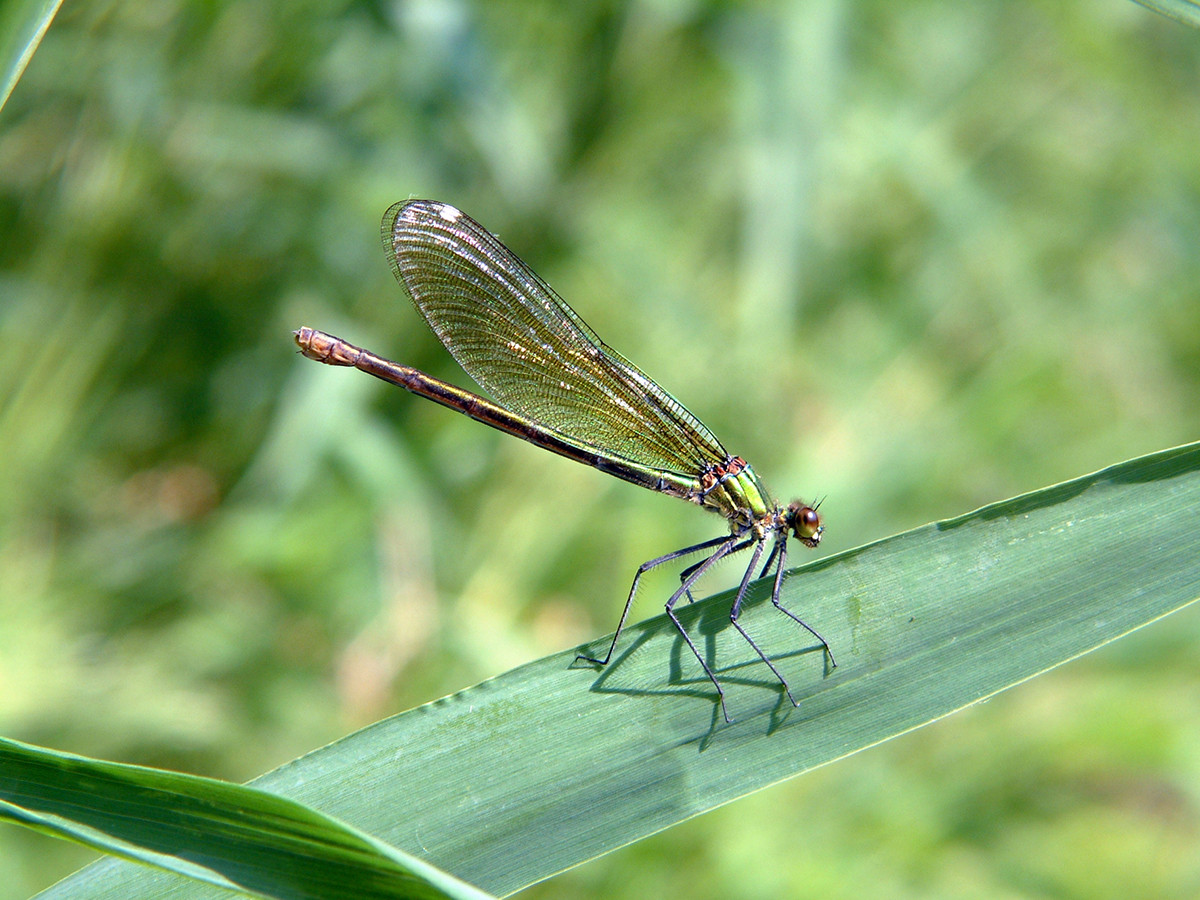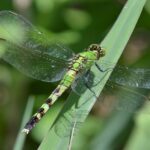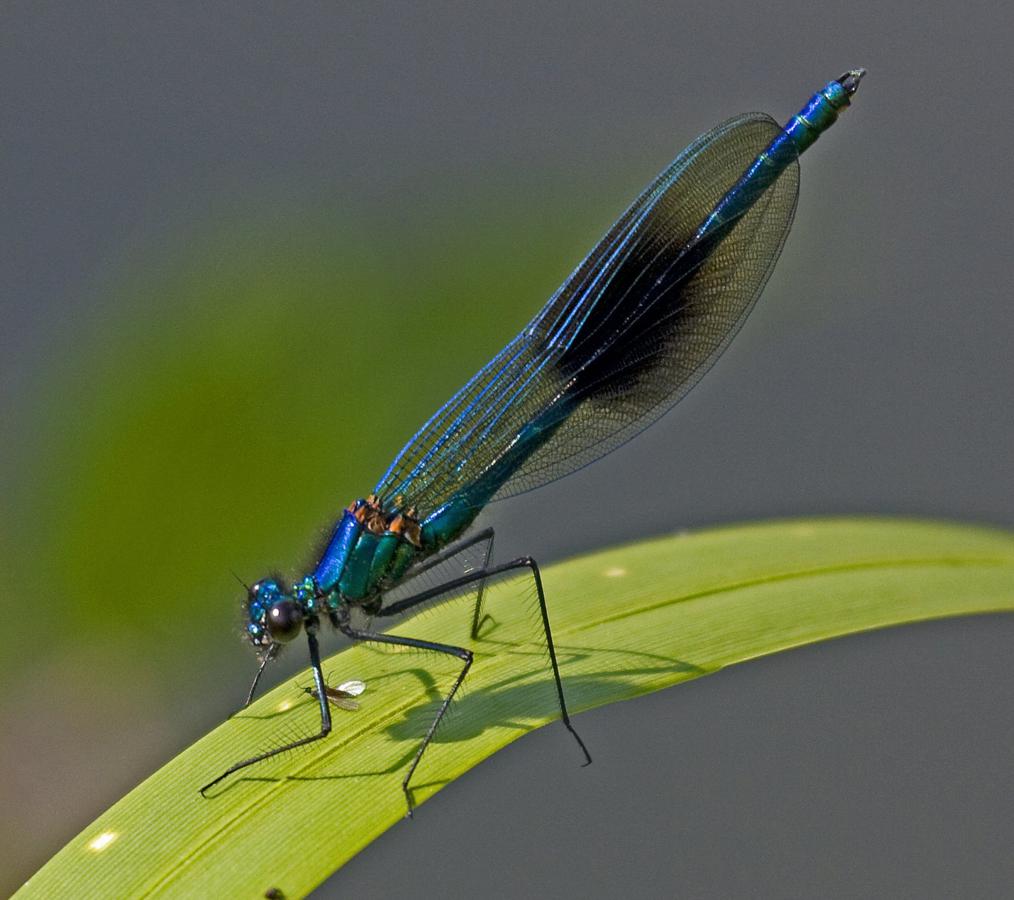
Large metallic damselfly with fluttering, butterfly-like wings.
Male: metallic blue body with broad dark blue-black spots across outer parts of wings.
Female: metallic green body with translucent pale green wings.
Habitat:Mainly found along slow-flowing lowland streams and rivers, particularly those with muddy bottoms.This species lives in many types of freshwater habitat, particularly open running water bodies such as streams and smaller rivers.
Status & Distribution:Common in Wales and most of England apart from in the north; however, its range is expanding. The species was first recorded from Scotland in 2002; it has now spread along the east coast and west coast in southern Scotland.
Adult Identification
- Length: 45mm
- Male: metallic blue body with broad dark blue-black spot across outer part of wing.
- Female: metallic green body with translucent pale green wings.
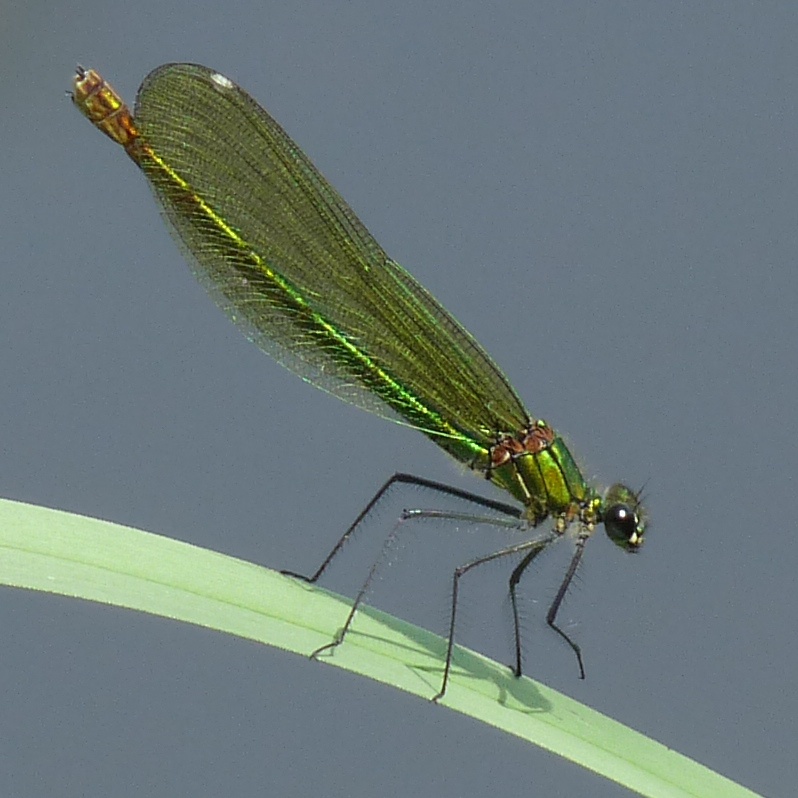
Larval Information
Demoiselle larvae have long bodies, short spikey caudal llamellae and long ‘horn-like’ antennae.No obvious occupital tooth sticking out from behind the eyes.Two pale bands on the caudal llamellae.Only Beautiful Demoiselle are similar in appearance.
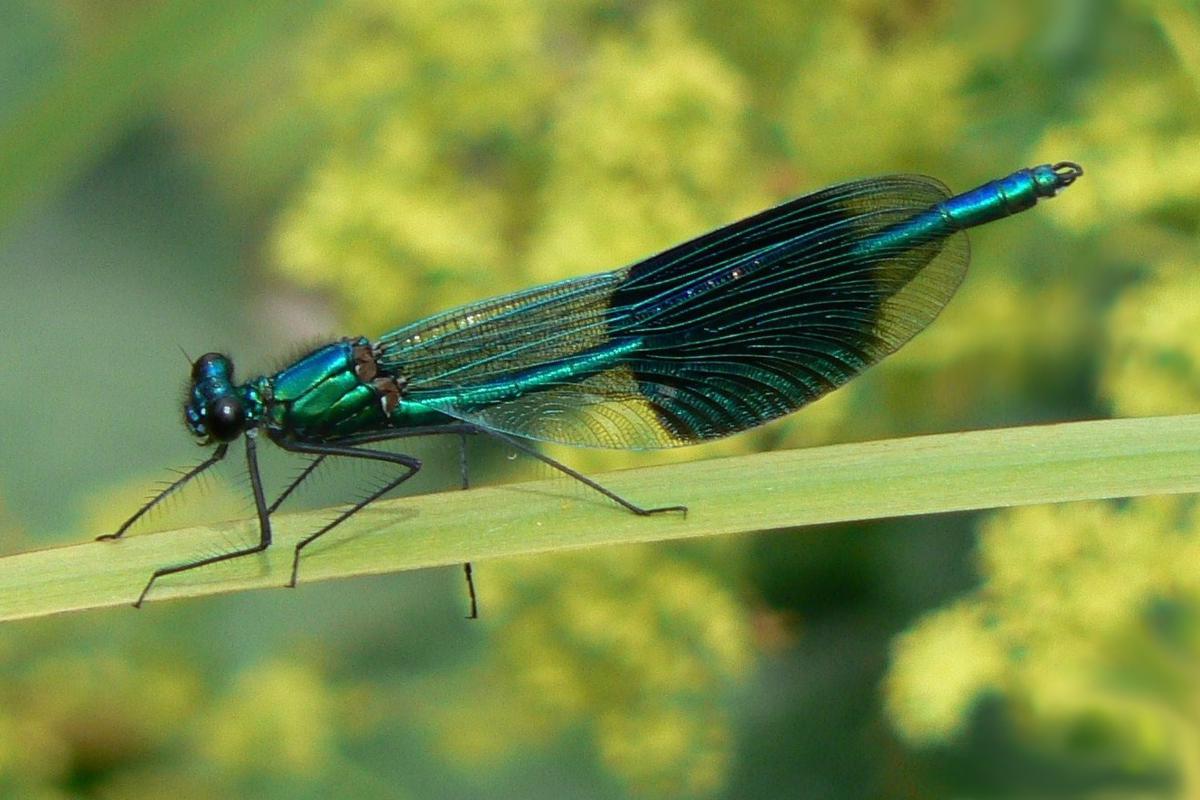
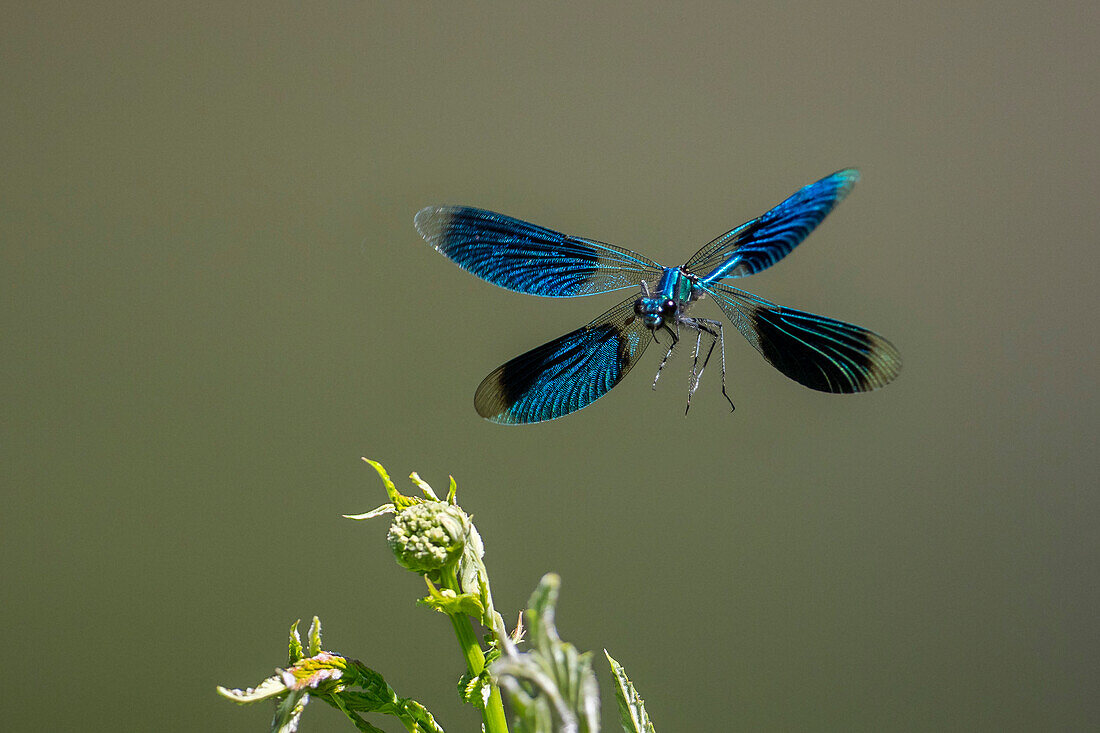
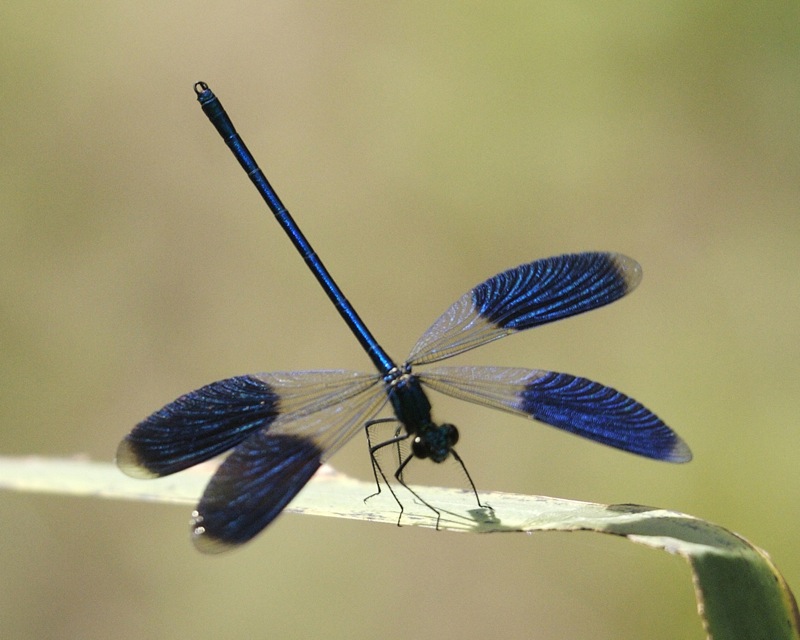
Description
This is a large damselfly with a total length of up to 48 millimetres (1.9 in) and a hindwing length of up to 36 millimetres (1.4 in).
Male and female are variable in color and pattern. The male has translucent wings which each have a broad, dark iridescent blue-black spot (or band) across the outer part. On immature individuals the spot is dark brown. The body can be a metallic blue or bluish green or a combination of both colours, depending on the time of year and location.
The dark wing patch of the male starts at the nodus (the slight dip midway down the upper edge of the wing) but can reach up to the wing-tip in southern races. In the very similar beautiful demoiselle (Calopteryx virgo), the dark patch starts before the nodus.
The female has translucent, pale green iridescent wings with a white patch near the tip (a pseudopterostigma), and a metallic green or bronze/green body.
Eggs and larvae
Females can lay up to 10 eggs per minute for 45 minutes. They lay in a wide variety of emergent or floating plants, sometimes even submerging to do so.
The eggs hatch after 14 days. The larvae have very long legs and are stick-shaped. They develop over two years, usually. They tolerate muddy water and overwinter buried in mud. When they are ready to moult into an adult, they climb up a suitable reed or plant and shed their skin.
The Banded demoiselle can be seen flitting around slow-moving rivers, ponds and lakes. The males are metallic blue, with a distinctive dark band across their wings, and the females are a shiny green.
How to identify
Male Banded demoiselles are metallic blue, with broad, dark blue patches on each wing; females are metallic green with pale greenish wings. Of the UK’s damselflies, only the Banded demoiselle and similar Beautiful demoiselle have coloured wings; the latter differs by displaying almost entirely dark, metallic wings. At rest, damselflies hold their wings along the length of their abdomen.
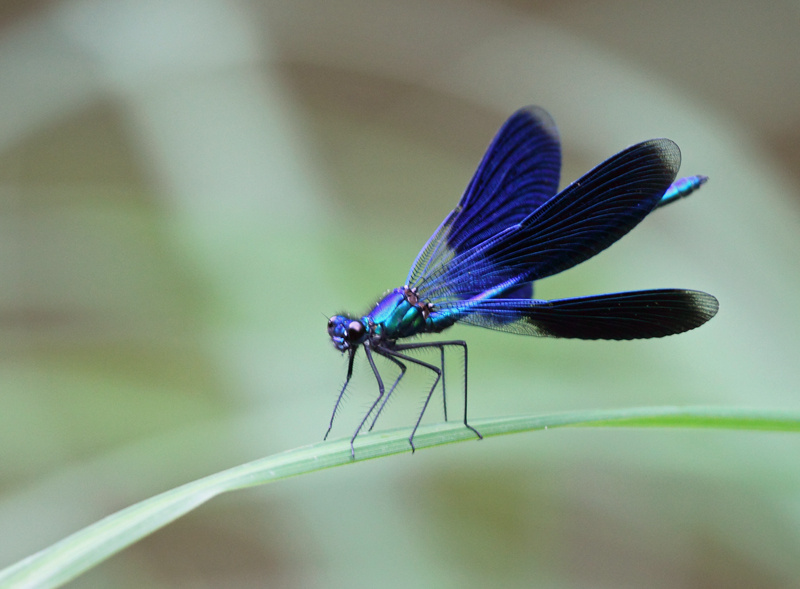
A remarkable, butterfly-like flying dragonfly with metallic blue shimmering wing bars. In the Donau-Auen National Park, the Banded Demoiselle is most likely to be seen on slow-moving backwaters, if only in limited numbers.
Description
A body length of approximately 5cm and wingspan of up to 6 or 7cm. Males have greenish-coloured wings with a broad, blackish-blue iridescent band around them which however does not cover either base or tips. Body is metallic blue-green. Females have greenish-coloured wings and a metallic green body. Both males and females fly like butterflies, mostly along the shore.
Distribution
The full range of this species encompasses nearly the entire Palearctic, from the Atlantic to China. In the National Park, limited to connected backwaters.
Endangerment and Conservation Status
Classified according to the Red List as “least concern” but near threatened in Germany and potentially threatened in Lower Austria. Rare to somewhat frequent in the National Park; found only on free-flowing backwaters.
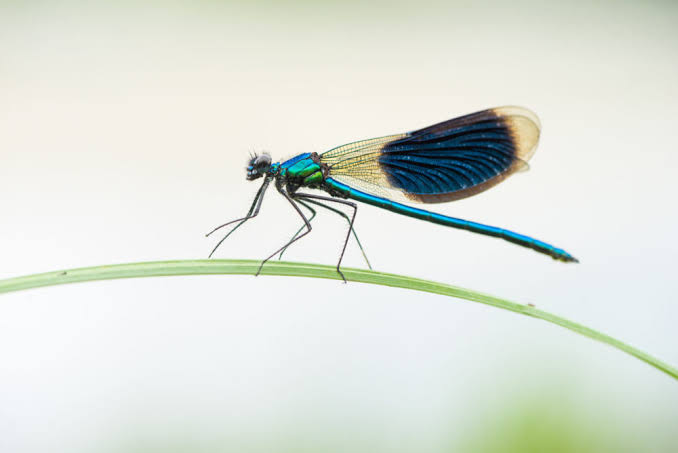
Behaviour
Males stake out their territory with a strange, whirring flight. Should other members of the species enter their territory, these intruders will be attacked. Eggs are deposited in floating plants; while laying their eggs, females are able to remain submerged under water with their entire bodies if necessary. Larvae have a two-year developmental stage; they may most likely be found in roots around undercut banks, but also on aquatic plants.
Special Characteristics
The Banded Demoiselle has nine different flight patterns: preying, defending, threatening, soaring, and display flights. Mating behaviour is also fascinating: first, males display the yellow-white underside of the tip of their abdomen to females flying by. Then they carry out a courtship display flight which culminates in mating.
Damselflies are similar to dragonflies, but hold their wings vertically above their body when at rest. Adults of damselflies and dragonflies are found near freshwater and all species have large eyes.
What do they look like?
The Banded Demoiselle is 42-45 mm long, with a wingspan of 60-65 mm.
Banded Demoiselle males have a metallic blue-green body and the wings have a broad band of dark bluish colouring in their outer third.
The females have a brilliant metallic green body and their wings are tinted green (each wing also has a tiny white spot near its tip).
The Beautiful Demoiselle (Calopteryx virgo) is similar, but its males have wings that are dark all over, not just in a central band, and its females have a brownish tinge to their wings.
Where do they live?
The Banded Demoiselle is found flying over rivers, streams and canals with moderate to slow flow, with beds of silt or mud, or resting on the waterside vegetation.
Where can they be found?
The Banded Demoiselle occurs throughout much of Europe. In Britain, it is generally found in lowland areas from the south coast to Lancashire and North Yorkshire.
When can you see them?
Adults are found flying from mid-May to September.
Life cycle
Mating lasts one to two minutes, after which the male will guard the female while she lays eggs on or in the leaves or stems of aquatic plants. The eggs take about two weeks to hatch, and the nymphs live underwater amongst roots or aquatic vegetation, usually for two years. When the nymphs have finished development, they crawl up the stems of aquatic plants into the air, where they shed their skin and emerge as winged adults.
What do they do?
Banded Demoiselles have a graceful fluttering flight, similar to that of a butterfly, and are usually seen flying over freshwater or riverside vegetation.
Did you know?
The females have to go underwater to lay their eggs! They are able to breathe whilst submerged, thanks to a trapped layer of air between their wings. The females can lay an egg every two to six seconds. Damselflies and dragonflies look beautiful but they are predators, catching other insects in flight when they are adults, and hunting them underwater as nymphs.

